p.315
p.321
p.327
p.333
p.339
p.345
p.351
p.357
p.363
Examination of the Surface Phosphorus Content of Anodized Medical Grade Titanium Samples
Abstract:
In case of titanium dental implants, the main goal is to create a surface where the bone cells can attach well, therefore osseointegration can occur. The chemical composition of the surface has an important role, because the surface has a direct contact with the living tissue and induces different reactions for example peri implantitis or osseointegration. In our work titanium sample made from the most commonly used dental implant material (Ti Grade 5) were investigated. The samples were treated by chemical etching in hydrogen-chloride and in phosphoric acid to remove the cut generated burr. After that the samples were anodized in phosphoric acid solution at 10 V, 20 V, 30 V or 40 V. As a result of these treatments, titanium-dioxide layers were created on the surfaces. Phosphorus (originating from the phosphoric acid bath) may also be found on the surfaces. This may promote osseointegration. The surface compositions were investigated with the aid of Secondary Ion Mass Spectrometry (SIMS). Based on these results we can conclude that anodization in phosphoric acid solution increases the phosphorus content of the surface. Approximately to the middle of the titanium-dioxide layer the phosphorus content is constant but lower with one order of magnitude than on the surface. In the deeper layers the phosphorus content continues to decrease until the base material where it significantly reduce.
Info:
Periodical:
Pages:
339-344
Citation:
Online since:
February 2015
Authors:
Price:
Сopyright:
© 2015 Trans Tech Publications Ltd. All Rights Reserved
Share:
Citation:


